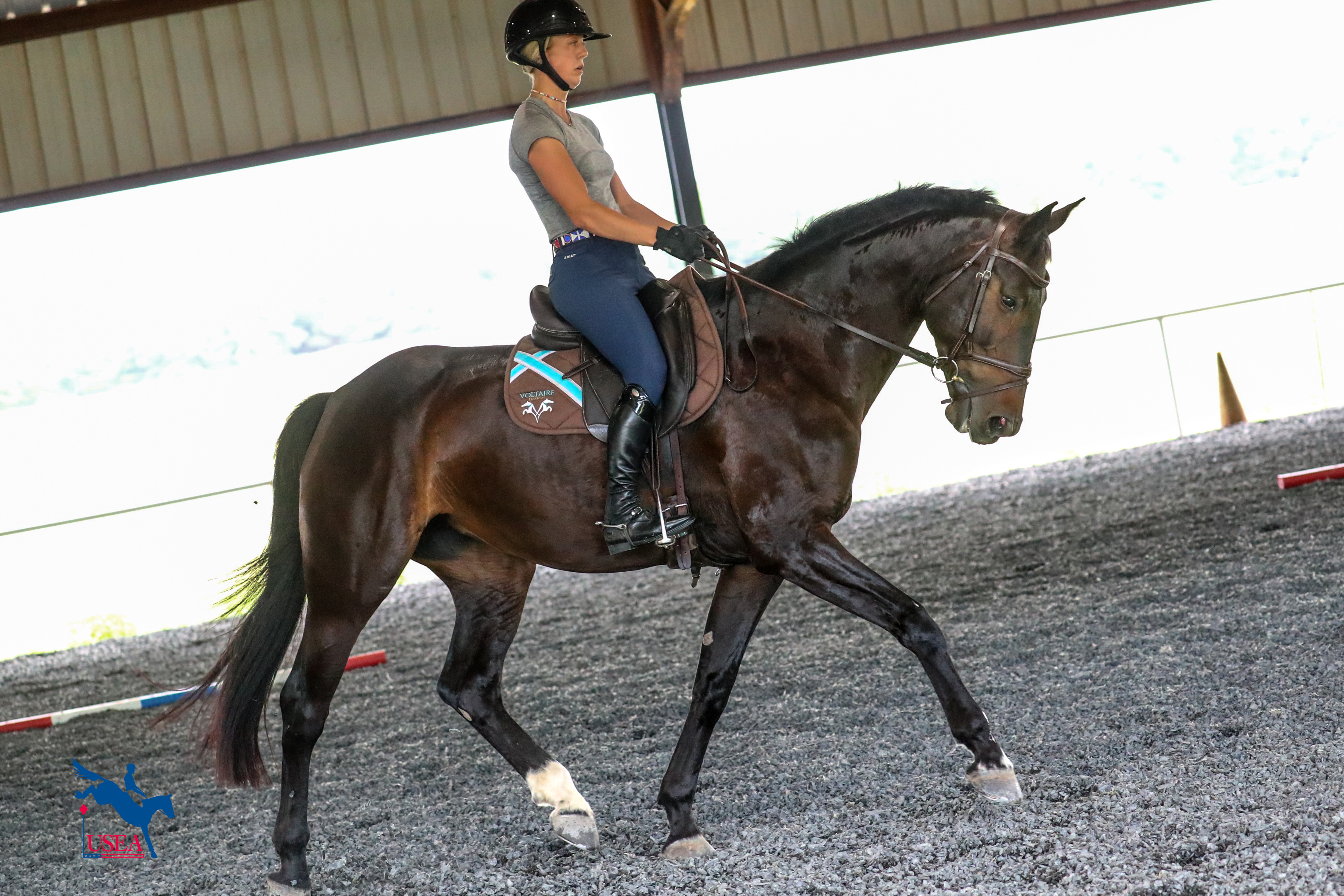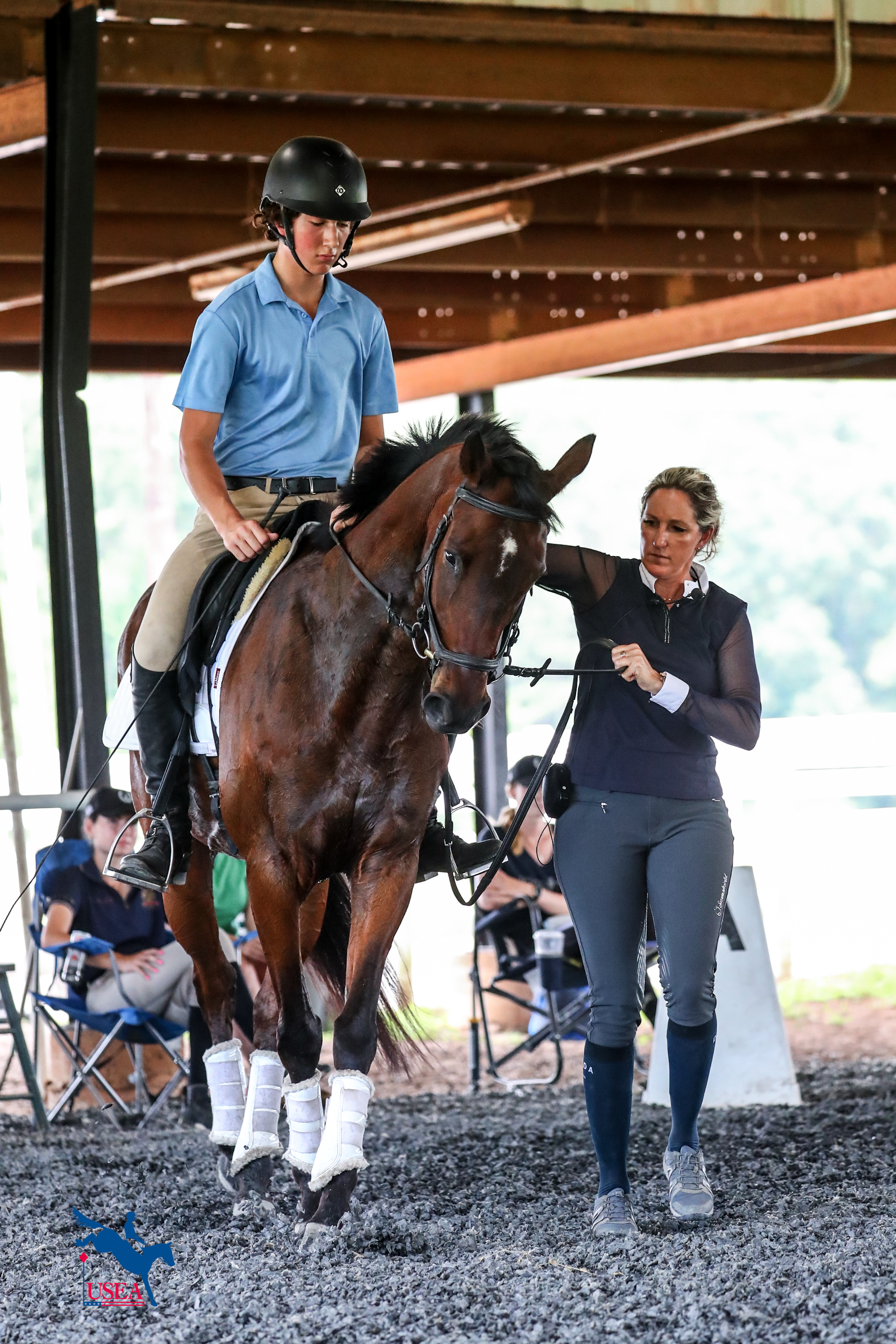Renew Your USEA Membership for the 2023 Season Today LEARN MORE

The USEA Emerging Athlete (EA21) Central Region Clinic kicked off at Holly Hill Farm in Benton, Louisiana, on June 10. USEA Eventing Coaches Program (ECP) instructor Rebecca “Bec” Braitling and 12 chosen young riders came together to experience an added level of training and development utilizing the skills that Braitling has developed as a professional eventer in her own right.
The Day 1 dressage portion of the clinic consisted of an emphasis on fine tuning the foundational basics of riding. Braitling emphasized that, “riders should be conscientious straight away when getting on,” and that it’s all about the movements and how to develop these to the highest degree. She stressed, “ride with intent, and picture it every time you get on.” This is how theory and goals come together as the stepping stones of what’s next in the real world of eventing.
As the clinic began, riders were split into six groups of two, and it was within these groups that Braitling used a combination of pre-riding questions and warm up observation in order to obtain the best way to coach them specifically.
This being said, riders were able to impart their needs as a response to the questioning. This was a basis of their own self-assessment of their riding challenges, and Braitling provided a focused, on-the-spot assessment, from the ground. Megan Hopkins, from the second group, explained her needs. “I was hoping to find new ways to improve my riding position,” she said. To be sure, she was given multiple things to try during these sessions to assist her in this endeavor.

Braitling made use of a differentiated teaching approachs that enabled individualized instruction for the participants, many of whom were training at different levels within their specified group. This approach used practical work hinged on developing more lateral suppleness and smoother transitions. She noted, “all should plan to have more transitions in their riding,” and that even a downward trot is a transition.
Refinements to position and movements in regard to alignment, stretching, and elongating the body, such as stretching the legs down and/or stretching the body up to strengthen the core were practiced. Vienna Allport, in the first group, said she discovered that, “we definitely struggle with straightness, but when I straighten my body it immediately straightens him more.” This goes along with Braitling’s claim that the rider’s alignment will assist the horse with his alignment.
Purposeful, consistent, conscientious use of the rider’s core, seat, hips, knees, legs, hands, and even your feet are all important in aligning “all your parts,” from top to bottom, which will help to make the horse available. Braitling added, “it’s significant to develop use of these skills that will transfer to other horses we will ride because it’s hard when we move on from a horse you used to have.”
As proof of this, she emphasized with the third group participants, Camryn Chung and Kelsey Seidel, “these are two very different horses within the same lesson who achieved very similar results.” So, these strategies, if employed accurately, have the potential to be used universally and successfully with other horses.
Several other additional skills were advised and then practiced to fine tune riding to the next precise level. Leg yields were implemented to help elasticize and bend the horse, thus Sierra Fishell from the first group incorporated this strategy to achieve a more forward bend to the outside of her leg yield while also achieving a relaxed thigh off the saddle.
All groups worked on collected and medium trot work alternating with collected and forward canter work, each of which used a start and stop hip movement to initiate each answer to the question directed to the horse.
“It’s important to remember it’s not all about repeating the exercise but more about developing collection and connection from the back to front of the horse,” said Braitling. The biggest thing is to move and stop your seat then try for a moment of suspension to improve gaits.

It was suggested to Camila Saenz, group 4, as a helpful strategy to develop a focal point on rhythm possibly by repeating a 1,2 1,2 pattern. Sylvia Byers, also group 4, was advised to ride more on her seat bones, and then practiced how to canter around orange cones and other objects placed in specific places and reminded to keep that visual in mind when performing circles.
Byers was riding a catch ride, Irish Jig Dancer, Holly Hill’s own, and the change in their session was progressively better the more Braitling instructed the specifics of being consistent along with other strategies.
Proper use of the reins was reiterated through most of the groups. Vienna Allport, group 1, practiced that it’s correct form and more effective to have thumbs up on the reins and to not cross over the center of the horse because, “your horse’s head is effected by how you treat the reins.”
Braitling assisted Daly Duarte, group 5, through a hands-on proximity modeling from the ground of how to work with the reins more effectively. Scarlett Peinado, also group 5, had the surprised realization that she was inadvertently dragging her horse to the left with the reins. Several of the participants found it more effective in communication of cues with the horse to keep your hands on the reins directly in front like you are holding a bowl. Also helpful with this is forming a “bridge” in front. Whichever works best is good because focusing on these things help to produce a more relaxed horse and answer the question “How am I going to improve the horse I’m sitting on?”
Hadley Bruce, group 2, had this to say about looking to the future after this clinic. “I’ve been stuck in the ‘He’s still young and green’ mindset. He’s 8 now, and we’re ready to put the pieces together to be a proper upper level pair. It’s just a wonderful feeling to have after five years.”
During Braitling’s instruction of group 6 with riders Katherine Hyndman and Camdyn Rahe, very high winds blew in. It is admirable to note that both riders remained calm as did their horses which is a testament to the connection they have with their horses.
It was a very productive day with many insights to be put into practice in the future. Riders are looking forward to taking what they’ve learned home and increasing the positive connections with their equine partner as they progress along the performance pathway of eventing.
Don't forget to follow the USEA’s coverage on social media!
Facebook | Instagram | Twitter
About the USEA Emerging Athlete U21 Program (EA21)
The purpose of the USEA Emerging Athletes U21 Program (EA21) is to identify and provide consistent quality instruction to the next generation of elite event riders. The aim is to create a pipeline for potential team riders by identifying and developing young talent, improving horsemanship and riding skills, and training and improving skills and consistency.
The USEA Emerging Athletes U21 Program was launched in 2022 with a model of five summertime regional clinics taught by selected USEA Eventing Coaches Program (ECP) instructors, leading to a winter national camp consisting of selected Young Riders from the regional clinics. Athletes who are 21 years or younger, are current members of their USEA Young Rider Area program, and are established at the Training Level or higher, are eligible to apply for the EA21 program. Click here to learn more about the USEA EA21 Program.
The USEA would like to thank Kerrits, Ride iQ, Sidelines Magazine and WeRideTogether for sponsoring the USEA Emerging Athletes U21 Program.